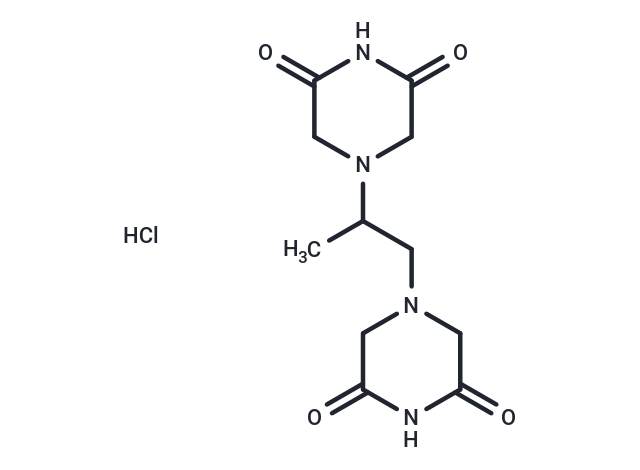Shopping Cart
- Remove All
 Your shopping cart is currently empty
Your shopping cart is currently empty

Cardioxane (ADR-529) is a cardio-protective drug.

| Pack Size | Price | Availability | Quantity |
|---|---|---|---|
| 5 mg | $30 | In Stock | |
| 10 mg | $46 | In Stock | |
| 25 mg | $71 | In Stock | |
| 50 mg | $92 | In Stock | |
| 100 mg | $121 | In Stock | |
| 200 mg | $188 | In Stock | |
| 500 mg | $317 | In Stock | |
| 1 mL x 10 mM (in DMSO) | $39 | In Stock |
| Description | Cardioxane (ADR-529) is a cardio-protective drug. |
| In vitro | Dexrazoxane (10 mM), known clinically to limit anthracycline cardiac toxicity, prevents daunorubicin-induced myocyte apoptosis, but not necrosis induced by higher anthracycline concentrations in rat cardiac myocytes. [1] Dexrazoxane presumably exerts its cardioprotective effects by either binding free or loosely bound iron, or iron complexed to doxorubicin, thus preventing or reducing site-specific oxygen radical production that damages cellular components. [2] Dexrazoxane specifically abolishes the DNA damage signal gamma-H2AX induced by doxorubicin, but not camptothecin or hydrogen peroxide, in H9C2 cardiomyocytes. Dexrazoxane also induces rapid degradation of Top2beta, which paralleles the reduction of doxorubicin-induced DNA damage. Dexrazoxane antagonizes doxorubicin-induced DNA damage through its interference with Top2beta, which could implicate Top2beta in doxorubicin cardiotoxicity. [3] Dexrazoxane is hydrolyzed to its active form intracellularly and binds iron to prevent the formation of superhydroxide radicals, thus preventing mitochondrial destruction. [4] |
| In vivo | Dexrazoxane combined with doxorubicin, daunorubicin, or idarubicin reduces the tissue lesions in B6D2F1 mice (expressed as area under the curve of wound size times duration) by 96%, 70%, and 87%, respectively. Dexrazoxane combined with doxorubicin, daunorubicin, or idarubicin results in a statistically significant reduction in the fraction of mice with wounds as well as the duration of wounds. [5] |
| Kinase Assay | HTRF assay: Homogeneous time-resolved fluorescence (HTRF) assay measures the signal generated by 2 components when they are in close proximity. The p53–MDM2 binding assay uses a biotinylated peptide derived from the MDM2-binding domain of p53 and a truncated N-terminal portion of recombinant human GST-tagged MDM2 protein containing the p53-binding domain. Proteins for crystal structure studies are expressed in E. coli strain BL21 using the helper plasmid pUBS 520 coding for the lacIq repressor and the rare tRNAArg [AGA/AGG]. For crystallization, the frozen protein is thawed and concentrated to 9.8 mg/mL using a Centricon concentrator (3,000 MW cutoff). The complex is then formed by combining the protein with a slight molar excess of the inhibitor (stock solution is 100 mM in DMSO) and this solution is allowed to sit for 4 hours at 4°C. Cryopreserved crystals are used to collect diffraction data on beamline X8C at the National Synchrotron Light Source at Brookhaven National Laboratory. |
| Alias | ICRF-187 hydrochloride, ICRF-187, Dexrazoxane HCl, Cardioxane hydrochloride, ADR-529 Hydrochloride, ADR-529 |
| Molecular Weight | 304.73 |
| Formula | C11H16N4O4·HCl |
| Cas No. | 149003-01-0 |
| Smiles | Cl.CC(CN1CC(=O)NC(=O)C1)N1CC(=O)NC(=O)C1 |
| Relative Density. | no data available |
| Storage | Powder: -20°C for 3 years | In solvent: -80°C for 1 year | Shipping with blue ice/Shipping at ambient temperature. | |||||||||||||||||||||||||||||||||||
| Solubility Information | H2O: 55 mg/mL (180.49 mM), Sonication is recommended. DMSO: 50 mg/mL (164.08 mM), Sonication is recommended. Ethanol: < 1 mg/mL (insoluble or slightly soluble) | |||||||||||||||||||||||||||||||||||
Solution Preparation Table | ||||||||||||||||||||||||||||||||||||
DMSO/H2O
| ||||||||||||||||||||||||||||||||||||

Copyright © 2015-2025 TargetMol Chemicals Inc. All Rights Reserved.